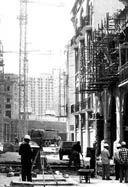
|
|
|
Lebanon is Open for Business Back to Beirut Courtesy of Al-Ayam Al-Jamilah - Pleasant Days Fall 1998, published by Aramco Services |
|
|
The rebuilding of downtown Beirut is underway, combining archaeological digs, new construction, underground parking, and the meticulous of selected historic buildings. |
Aramco annuitants with memories of "Pleasant Days" once spent in Lebanon can put the lovely, cosmopolitan land at the eastern end of the Mediterranean Sea back on their list of favorite places to revisit in retirement. After more than 20 years of civil turmoil that kept foreign visitors away in droves, business travelers and an increasing number of tourists are venturing back to the country once known as the "Switzerland of the Middle East." And with tranquility restored and reconstruction under way, recent visitors report that the famous spirit of hospitality and joie de vivre that made its capital the "Paris of the Middle East" are alive and flourishing. The U.S. State Department has dropped its ban on Americans traveling to Lebanon, European airlines are flying into Beirut's spanking new air terminal and tourist visas can be purchased on arrival. There was a time in the 1950s, '60s and early '70s when Beirut was the "short leave" vacation spot of choice for most Aramcons. Lebanon's cool mountains, waterfront cafes and bountiful arrays of fresh fruits and flowers were one aspect of the Mediterranean country's attraction for desert dwellers. Others sought out its historic ruins, shopping and Beirut's gold suqs, or its elegant restaurants and sophisticated nightlife. Over the years many Aramcons had Beirut or Sidon assignments with Tapline and AOC. For nearly three decades many second- generation Aramcons attended the American Community School. Numbers of Saudi Arab employees and a few Americans studied at International College and the American University. |
|
City planners have placed upbeat, playful artwork throughout the construction site of central Beirut's principal square. The gigantic billboard depicts the future view toward the Mediterranean. |
Now, once again, Beirut is bustling. Some familiar hotels are operating - the Riviera, the Commodore, the Mayflower. Though rooms are not the bargains they once were, moderate rates can be found. Although the fashionable St. Georges beach club is open, the adjoining hotel is still a burnt-out shell. Reconstruction of the Phoenicia began last summer. Restaurant prices are like those of similar quality in the United States. New highway overpasses and automobile tunnels cut through old districts of the city. Americans can rent a car using their U.S. drivers' license, although timid tourists will possibly prefer to sit behind one of Beirut's notorious taxi drivers, rather than facing him on the road. The international educational institutions that were Beirut's hallmark have survived the war years and are busily adapting their curricula for the 21st century. The campus of the American University of Beirut is the oasis of tranquility that many Aramcons will remember, though one recent visitor was surprised to see every other passing student speaking into a cellular phone. The seaside Corniche is still a pleasant place to stroll at sunset, as before, but seeing young Lebanese couples jogging together or skating by on roller blades may surprise visitors returning after a long absence. |
|
In the Chouf Mountains south of Beirut, a new national park protects isolated groves of ancient Lebanese cedars and oaks. With goats kept out by rangers, thousands of tiny cedar seedlings are flourishing in the shelter of the older trees. |
A visit to the flattened central business district between Bab Edriss and Martyrs' Square, now the site of massive reconstruction and meticulous restoration, is simultaneously saddening and inspiring. In other areas, especially along some 10 miles of crowded coastal strip north and south of Beirut, a jungle of unregulated multi-story concrete buildings has swallowed up onetime plantations of oranges and bananas. Further along the coasts, however, and once into the mountains above suburban foothills, Lebanon's famous natural beauty still resides. In the north, the port of Byblos, the olive groves above Tripoli, and the steeply terraced hillsides on the winding road to the famous Cedars of Lebanon still draw visitors. In the south, roadside cafes on the banks of cold-running mountain streams still tempt travelers en route to the stone-cut, orange-roofed villages around Beit Eddine. In the central Bekaa Valley, Roman Baalbek has already hosted its first revived summer music festival. So Lebanon is again open for business. The welcome sign is out. Those Aramcons who were regular visitors to the Beirut of 20 years ago may find themselves mourning the passing of the particular city they carry in their memory. But they can be assured that there is still plenty to love about the eternal Beirut once again rising like the Phoenix from its ashes. |
 981211/bl |
|


